Heterogeneity and Cause Analysis of Organic Pore in Upper Permian Shale from Western Hubei, South China
Abstract
1. Introduction
2. Geological Setting
3. Samples and Methods
4. Results
4.1. TOC Content and Variations
4.2. FE-SEM Images
4.3. Low-Temperature Nitrogen Adsorption Experiments
4.4. Fractal Dimensions of Organic Matter Pores
5. Discussion
5.1. Morphology of Organic Pores
5.1.1. Organic Pore Morphology Under FE-SEM
5.1.2. Organic Pore Morphology Reflected by N2 Adsorption–Desorption
5.2. Size Distribution of Organic Matter Pores
5.3. Specific Surface Area and Pore Volume of Organic Matter Pores
5.3.1. Specific Surface Area and Pore Volume
5.3.2. Correlation Among Surface Area, Pore Volume, and Average Pore Size
5.4. Heterogeneity of Organic Pores
5.5. Causes of Heterogeneity in Organic Pores
6. Conclusions
Author Contributions
Funding
Data Availability Statement
Conflicts of Interest
References
- Nie, H.K.; Zhang, G.R.; Li, P.; Ding, J.H.; Dang, W.; Sun, C.X.; Zhang, P.X.; Wang, J.; Yang, C.; Li, P.; et al. Research progress and prospects of shale organic pores. Acta Pet. Sin. 2022, 43, 1770–1787, (In Chinese with English Abstract). [Google Scholar] [CrossRef]
- Jin, Z.J.; Hu, Z.Q.; Gao, B.; Zhao, J.H. Enrichment and high-yield controlling factors of shale gas in the Wufeng–Longmaxi formations in southeastern Sichuan Basin. Earth Sci. Front. 2016, 23, 1–10, (In Chinese with English Abstract). [Google Scholar] [CrossRef]
- Zhang, Y.Y.; He, Z.L.; Lu, S.F.; Xiao, D.S.; Li, Y.F.; Liu, Y. Organic pore heterogeneity and its impact on absorption capacity in shale reservoirs in the Wufeng and Longmaxi formations, South China. Energy Geosci. 2025, 6, 100427. [Google Scholar] [CrossRef]
- Curtis, M.E.; Cardott, B.J.; Sondergeld, C.H.; Rai, C.S. Development of organic porosity in the Woodford Shale with increasing thermal maturity. Int. J. Coal Geol. 2012, 103, 26–31. [Google Scholar] [CrossRef]
- He, Z.L.; Nie, H.K.; Zhang, Y.Y. Main controlling factors of shale gas enrichment in the Ordovician Wufeng Formation–Silurian Longmaxi Formation in the Sichuan Basin and its surrounding areas. Earth Sci. Front. 2016, 23, 8–17, (In Chinese with English Abstract). [Google Scholar] [CrossRef]
- Teng, G.E.; Lu, L.F.; Yu, L.J.; Zhang, W.T.; Pan, A.Y.; Shen, B.J.; Wang, Y.; Yang, Y.F.; Gao, Z.W. Control of the formation, preservation and connectivity of organic matter pores in shale. Pet. Explor. Dev. 2021, 48, 687–699, (In Chinese with English Abstract). [Google Scholar] [CrossRef]
- Nie, H.K.; Zhang, J.C.; Jin, Z.J.; Liu, Q.Y.; Li, S.J.; Dang, W.; Li, P.; Bian, R.K.; Sun, C.X.; Zhang, K.; et al. On the enrichment mechanism of marine shale gas: A case study of the Wufeng–Longmaxi formations in the Sichuan Basin. Acta Geol. Sin. 2024, 98, 975–991, (In Chinese with English Abstract). [Google Scholar] [CrossRef]
- Loucks, R.G.; Reed, R.M.; Ruppel, S.C.; Hammes, U. Morphology, genesis, and distribution of nanometer-scale pores in siliceous mudstones of the Mississippian Barnett Shale. J. Sediment. Res. 2009, 79, 848–861. [Google Scholar] [CrossRef]
- Nie, H.K.; He, Z.L.; Liu, G.X.; Du, W.; Wang, R.Y.; Zhang, G.R. Genetic mechanism of high-quality shale gas reservoirs in the Wufeng–LongmaxiFms in the Sichuan Basin. Nat. Gas Ind. 2020, 40, 31–41, (In Chinese with English Abstract). [Google Scholar] [CrossRef]
- Qu, Y.; Ouyang, S.; Gao, J.; Shi, J.; Wu, Y.; Cheng, Y.; Zhou, Z.; Lyu, Z.; Sun, W.; Wu, H. Pore space characteristics and migration changes in hydrocarbons in shale reservoir. Fractal Fract. 2024, 8, 588. [Google Scholar] [CrossRef]
- Modica, C.J.; Lapierre, S.G. Estimation of kerogen porosity in source rocks as a function of thermal transformation: Example from the Mowry Shale in the Powder River Basin of Wyoming. AAPG Bull. 2012, 96, 87–108. [Google Scholar] [CrossRef]
- Ji, L.M.; Wu, Y.D.; He, C.; Su, L. High-pressure hydrocarbon generation simulation and pore evolution characteristics of organic-rich shale. Acta Pet. Sin. 2016, 37, 172–181, (In Chinese with English Abstract). [Google Scholar] [CrossRef]
- Liu, B. Organic matter in shale: Type, thermal evolution, and organic pores. Earth Sci. J. China Univ. Geosci. 2023, 48, 4641–4657, (In Chinese with English Abstract). [Google Scholar] [CrossRef]
- Zhang, K.; Xi, Z.D.; Zhang, S.H.; Tang, S.H.; Lv, J.W.; Nie, H.K.; Lin, D.L. Characteristics of organic matter types and organic matter pore development in marine–continental transitional shale. Geol. J. 2025, 60, 2095–2113. [Google Scholar] [CrossRef]
- Nie, H.; Jin, Z.; Zhang, J. Characteristics of three organic matter pore types in the Wufeng–Longmaxi Shale of the Sichuan Basin, Southwest China. Sci. Rep. 2018, 8, 7014. [Google Scholar] [CrossRef]
- Jin, Z.J.; Liu, G.X.; Wang, P.W.; Nie, H.K.; Li, M.; Wang, G.P. Exploration potential and direction of Permian shale gas in the Yangtze region, South China. Pet. Oil Nat. Gas Geol. 2025, 46, 335–347, (In Chinese with English Abstract). [Google Scholar] [CrossRef]
- Qiu, Z.; Dou, L.R.; Wu, J.F.; Wei, H.Y.; Liu, W.; Kong, W.L.; Zhang, Q.; Cai, G.Y.; Zhang, G.; Wu, W.; et al. Lithofacies palaeogeographic evolution of the Middle Permian sequence stratigraphy and its implications for shale gas exploration in the northern Sichuan and western Hubei provinces. Earth Sci. J. China Univ. Geosci. 2024, 49, 712–748, (In Chinese with English Abstract). [Google Scholar] [CrossRef]
- Song, T.; Li, S.Z.; Zhang, Y.L.; Bao, H.Y.; Liu, H.T.; Xu, Q.C.; Li, H.H.; Wang, Y.Y.; Wang, Y.; Xie, T.; et al. Differences and controlling factors of shale gas enrichment conditions in the Upper Permian marine shale of western Hubei: A case study of the Wujiaping Formation member 2 in Hongxing block and the Dalong Formation in Enshi area. Nat. Gas Geosci. 2023, 34, 1425–1441, (In Chinese with English Abstract). [Google Scholar] [CrossRef]
- Zhai, C.B.; Mu, C.L.; Liang, W.; Zheng, B.S.; Zan, B.W. Sedimentary evolution of the Permian Gufeng–Dalong formations in western Hubei and its geological significance for shale gas. Miner. Petrol. 2021, 41, 114–124, (In Chinese with English Abstract). [Google Scholar] [CrossRef]
- Peng, J.N.; Du, C.J.; Li, L.L.; Jiang, X.Q.; Pan, W.L.; Lu, Y.D.; Luo, K.P. Lithofacies palaeogeography of Middle Permian in the Sichuan Basin and its petroleum geological significance. Pet. Geol. Exp. 2023, 45, 49–59, (In Chinese with English Abstract). [Google Scholar] [CrossRef]
- Liang, X.W.; Li, L. Geological conditions and exploration potential for shale gas in Upper Permian Wujiaping Formation in the region of western Hubei–eastern Chongqing. Pet. Geol. Exp. 2021, 43, 386–394, (In Chinese with English Abstract). [Google Scholar] [CrossRef]
- Zhang, Y.; Shen, B.; Gao, B.; Feng, D.; Wang, P.; Li, M.; Li, Y.; Liu, Y. Characteristics of microorganisms and origins of organic matter in Permian shale in northwestern Sichuan Basin, South China. Processes 2025, 13, 2080. [Google Scholar] [CrossRef]
- Li, S.Z.; Zhou, Z.; Li, F.; Shen, B.; Xu, Q.C.; Song, T.; Zhang, X.T.; Yang, X.G.; Hu, C.Z.; Wang, C.; et al. Shale gas enrichment conditions and favorable exploration areas of the Upper Permian Dalong Formation in western Hubei–eastern Chongqing. Nat. Gas Ind. 2024, 44, 1–15, (In Chinese with English Abstract). [Google Scholar] [CrossRef]
- Zhuo, J.W.; Wang, J.; Wang, Z.J.; Xie, Y.; Yang, P.; Liu, J.Q.; Zhao, Z. Sedimentary characteristics of the Late Permian in western Hubei and the evolution of intra-platform rift troughs. Xinjiang Pet. Geol. 2009, 30, 300–303, (In Chinese with English Abstract). [Google Scholar]
- Liang, X.Q.; Zhou, Y.; Jiang, Y.; Wen, S.N.; Fu, J.G.; Wang, C. Sedimentary response differences of the Dongwu Movement in the Permian: Evidence from LA-ICPMS U–Pb zircon ages of the Wujiaping or Longtan formations in the Yangtze and Cathaysia plates. Acta Petrol. Sin. 2013, 29, 3592–3606, (In Chinese with English Abstract). [Google Scholar]
- Huang, H.; He, D.F.; Li, Y.Q.; Li, D.; Zhang, Y.; Chen, J.J. Late Permian tectono-sedimentary setting and basin evolution in the Upper Yangtze region, South China: Implications for the formation mechanism of intra-platform depressions. J. Asian Earth Sci. 2021, 205, 104599. [Google Scholar] [CrossRef]
- Zhao, P.R.; Gao, B.; Guo, Z.F.; Wei, Z.H. Exploration potential of shale gas in the Upper Permian marine–continental transitional facies and deep-water shelf facies in the Sichuan Basin. Pet. Explor. Exp. 2020, 42, 335–344, (In Chinese with English Abstract). [Google Scholar] [CrossRef]
- Brunauer, S.; Emmett, P.H.; Teller, E. Adsorption of gases in multimolecular layers. J. Am. Chem. Soc. 1938, 60, 309–319. [Google Scholar] [CrossRef]
- Lowell, S.; Shields, J.E.; Thomas, M.A.; Thommes, M. Characterization of Porous Solids and Powders: Surface Area, Pore Size and Density; Kluwer Academic Publishers: Dordrecht, The Netherlands, 2004. [Google Scholar]
- Han, H.; Guo, C.; Zhong, N.N.; Pang, P.; Gao, Y. A study on fractal characteristics of lacustrine shales of Qingshankou Formation in the Songliao Basin, northeast China using nitrogen adsorption and mercury injection methods. J. Pet. Sci. Eng. 2020, 193, 107378. [Google Scholar] [CrossRef]
- Pfeifer, P.; Avnir, D. Chemistry in noninteger dimensions between two and three. I. Fractal theory of heterogeneous surfaces. J. Chem. Phys. 1983, 79, 3558–3565. [Google Scholar] [CrossRef]
- Li, Q.; Chen, R.Q.; Shang, F.; Li, L.; Bai, X. Pore structure and fractal characteristics of shale reservoirs in the Jurassic Lianggaoshan Formation, northeastern Sichuan Basin. Pet. Geol. Exp. 2025, 47, 323–335, (In Chinese with English Abstract). [Google Scholar] [CrossRef]
- Ji, W.M.; Song, Y.; Jiang, Z.X.; Meng, M.M.; Liu, Q.X.; Chen, L.; Wang, P.F.; Gao, F.L.; Huang, H.X. Fractal characteristics of nano-pores in the Lower Silurian Longmaxi shales from the Upper Yangtze Platform, South China. Mar. Pet. Geol. 2016, 78, 88–98. [Google Scholar] [CrossRef]
- Hou, Y.G.; He, S.; Yi, J.Z.; Zhang, B.Q.; Chen, X.H.; Wang, Y.; Zhang, J.K.; Cheng, C.Y. Effect of pore structure on methane sorption potential of shales. Pet. Explor. Dev. 2014, 41, 272–281. [Google Scholar] [CrossRef]
- He, H.F.; Liu, P.C.; Xu, L.; Hao, S.Y.; Qiu, X.Y.; Shan, C.; Zhou, Y.L. Pore structure representations based on nitrogen adsorption experiments and an FHH fractal model: Case study of the block Z shales in the Ordos Basin, China. J. Pet. Sci. Eng. 2021, 203, 108661. [Google Scholar] [CrossRef]
- Thommes, M.; Kaneko, K.; Neimark, A.V.; Olivier, J.P.; Rodriguez-Reinoso, F.; Rouquerol, J.; Sing, K.S.W. Physisorption of gases, with special reference to the evaluation of surface area and pore size distribution (IUPAC Technical Report). Pure Appl. Chem. 2015, 87, 1051–1069. [Google Scholar] [CrossRef]
- Feng, X.L.; Ao, W.H.; Tang, X. Development characteristics and controlling factors of pores in continental shale gas reservoirs: A case study of Chang 7 Member in the Ordos Basin. J. Jilin Univ. Earth Sci. Ed. 2018, 48, 678–692, (In Chinese with English Abstract). [Google Scholar] [CrossRef]
- Song, Z.Z.; Abud, A.; Lü, M.Y.; Zhang, Y.Q.; Jiang, F.J.; Liu, Z.Y.; Zheng, W.; Wang, X.Y. Quantitative analysis of nitrogen adsorption hysteresis loops and its implications for pore structure characterization: A case study of the Upper Triassic Yanchang Formation Member 7 in the Ordos Basin. Pet. Oil Nat. Gas Geol. 2023, 44, 495–509, (In Chinese with English Abstract). [Google Scholar] [CrossRef]
- Cai, G.Y.; Jiang, Y.Q.; Li, X.T.; Sun, S.S.; Fu, Y.H.; Gu, Y.F.; Wang, Z.L.; Ji, C.H. Differences in reservoir characteristics between transitional and marine organic-rich shales. Acta Sedimentol. Sin. 2022, 40, 1030–1042, (In Chinese with English Abstract). [Google Scholar] [CrossRef]
- Ding, S.T.; Huang, Y.; Zhang, Y.Y.; Wang, H.B.; Cao, Q. Types of shale organic matter in China and related pore characteristics. J. Sichuan Geol. 2022, 42, 23–28, (In Chinese with English Abstract). [Google Scholar] [CrossRef]
- Wang, P.W.; Liu, Z.B.; Zhang, D.W.; Li, X.; Du, W.; Liu, H.T.; Li, P.; Wang, R.Y. Control of organic matter enrichment on organic pore development in marine Permian shales of eastern Sichuan. Pet. Oil Nat. Gas Geol. 2023, 44, 379–392, (In Chinese with English Abstract). [Google Scholar] [CrossRef]
- Zhang, T.S.; Yang, Y.; Gong, Q.S.; Liang, X.; Wei, X.F. Microscopic pore characteristics and controlling factors of Early Paleozoic marine shales in southern Sichuan Basin. Acta Geol. Sin. 2014, 88, 1728–1740, (In Chinese with English Abstract). [Google Scholar] [CrossRef]
- Dong, C.M.; Ma, C.F.; Luan, G.Q.; Lin, C.Y.; Zhang, X.G.; Ren, L.H. Shale pyrolysis simulation experiments and diagenetic evolution model. Acta Sedimentol. Sin. 2015, 33, 1053–1061, (In Chinese with English Abstract). [Google Scholar] [CrossRef]
- Teng, G.E.; Shen, B.J.; Yu, L.J.; Yang, Y.F.; Zhang, W.T.; Tao, C.; Xi, B.B.; Zhang, Q.Z.; Bao, F.; Qin, J.Z. Formation and accumulation mechanisms of shale gas in the Wufeng–Longmaxi formations, Sichuan Basin. Pet. Explor. Dev. 2017, 44, 69–78, (In Chinese with English Abstract). [Google Scholar] [CrossRef]
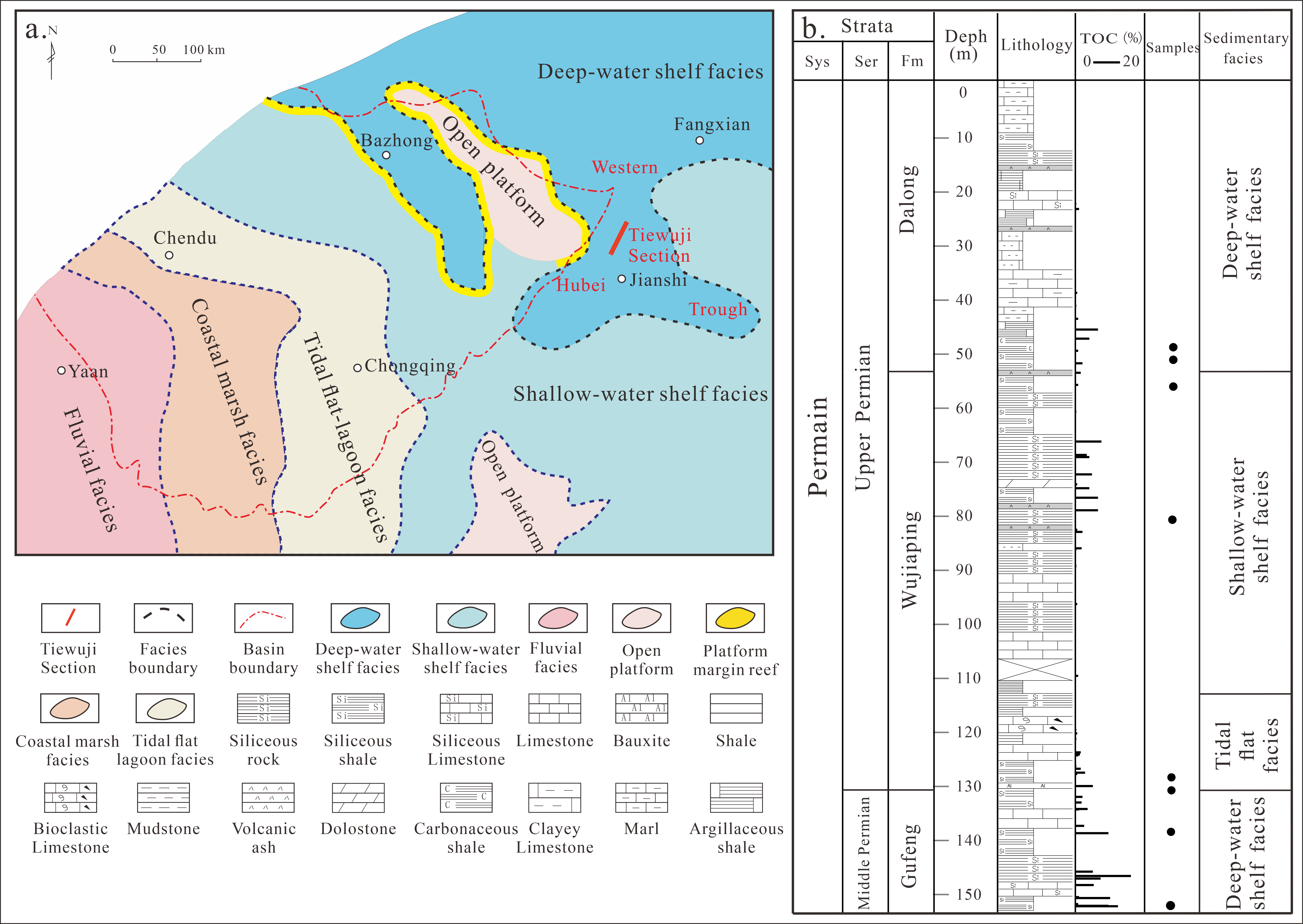

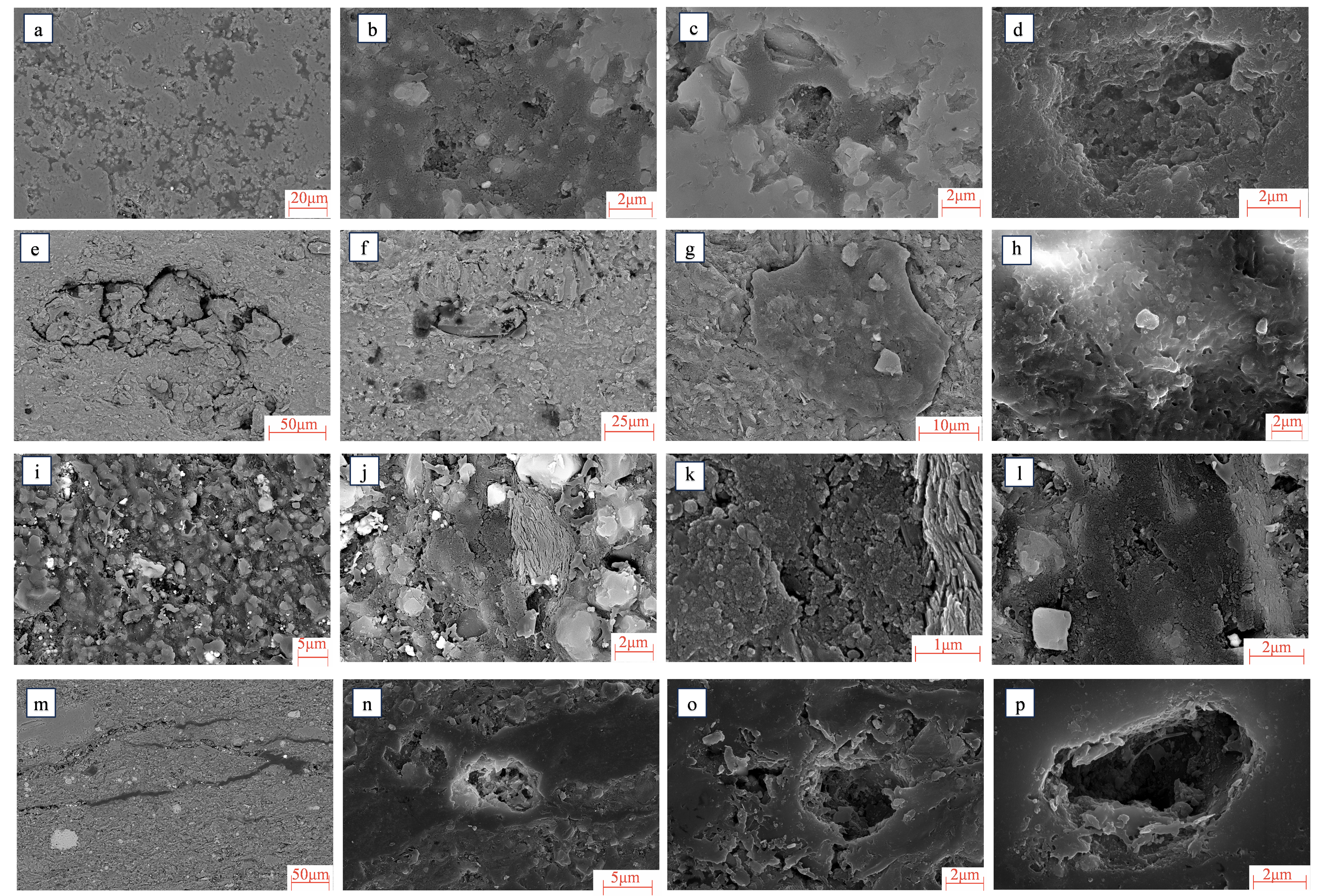
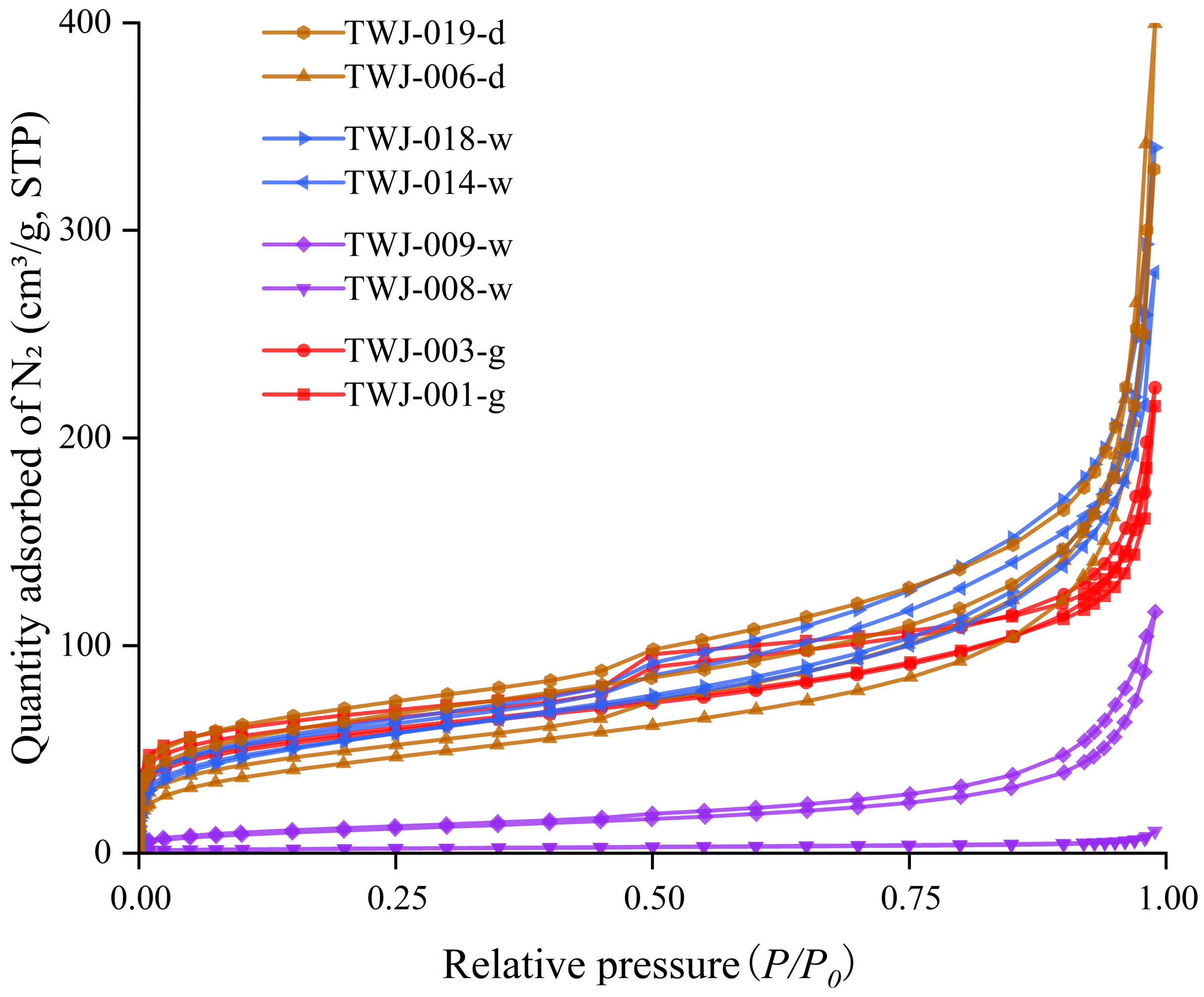


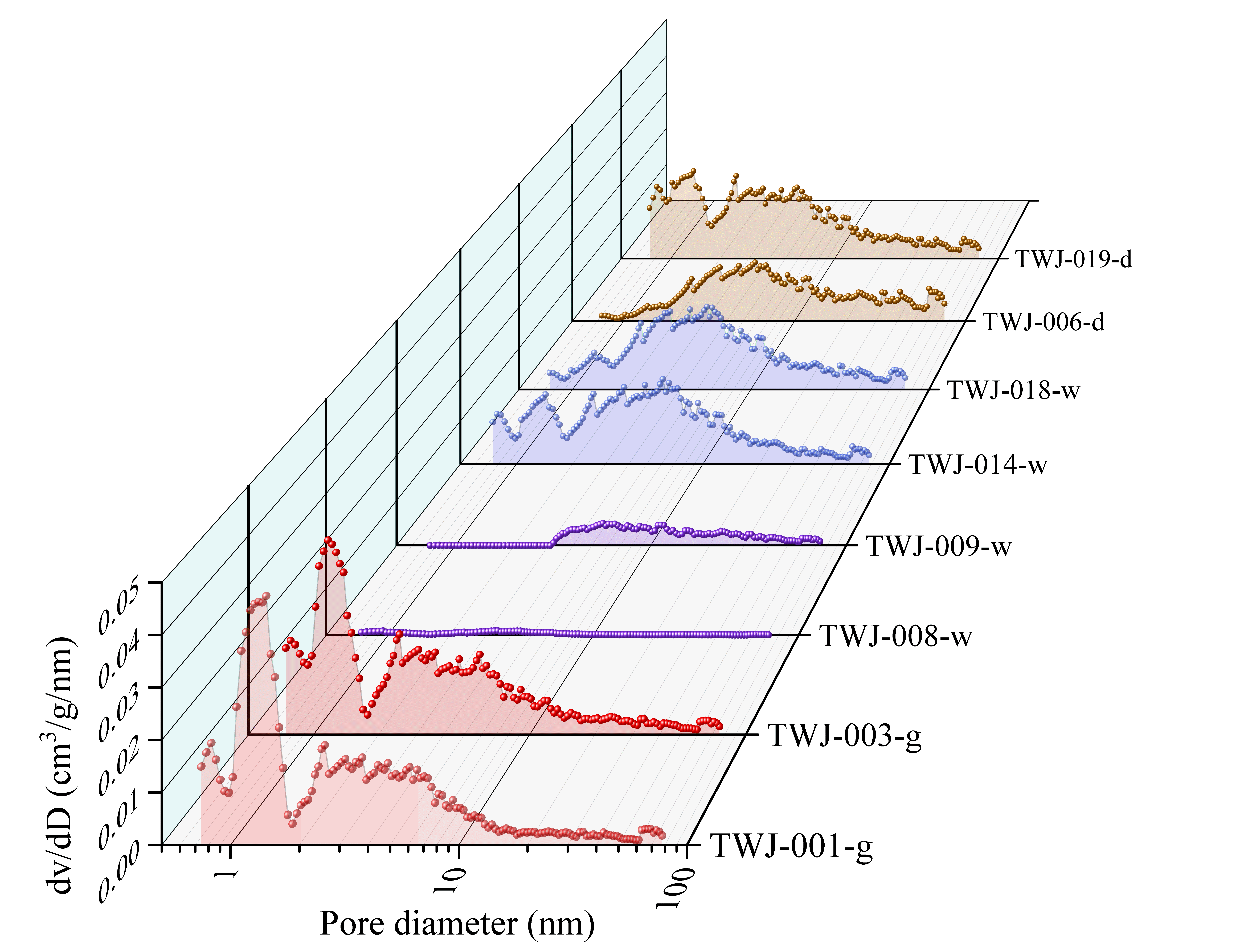
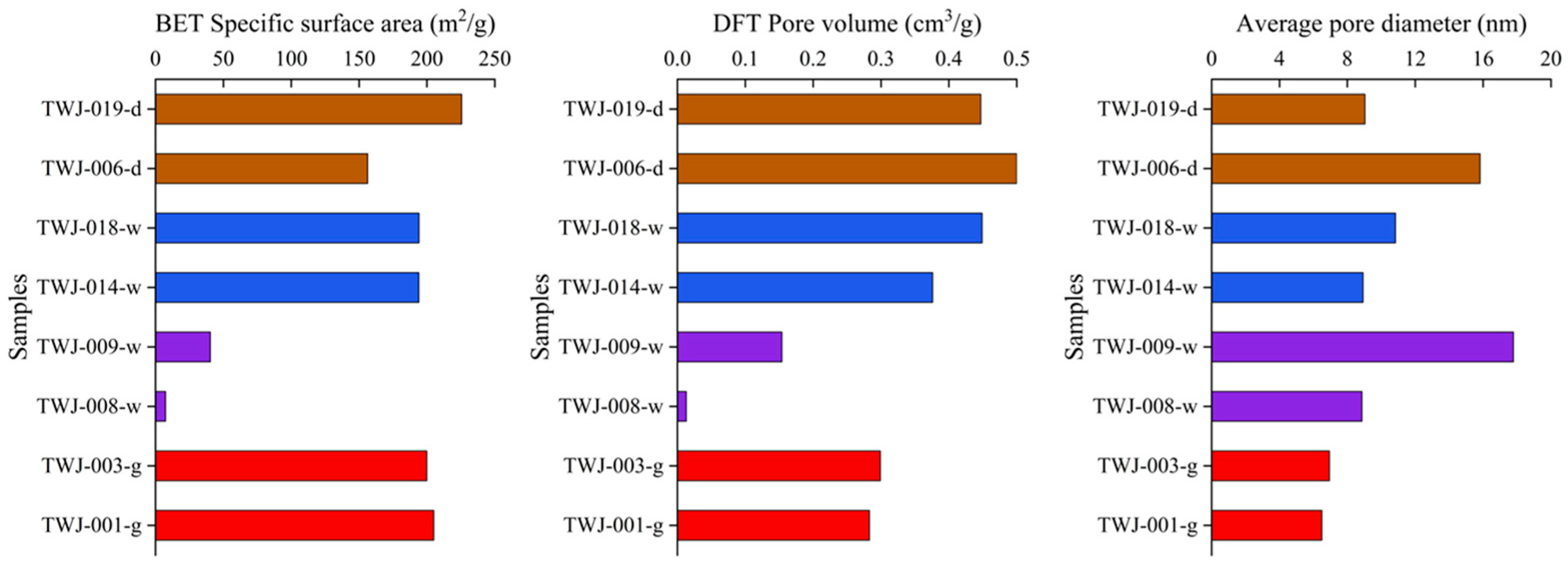


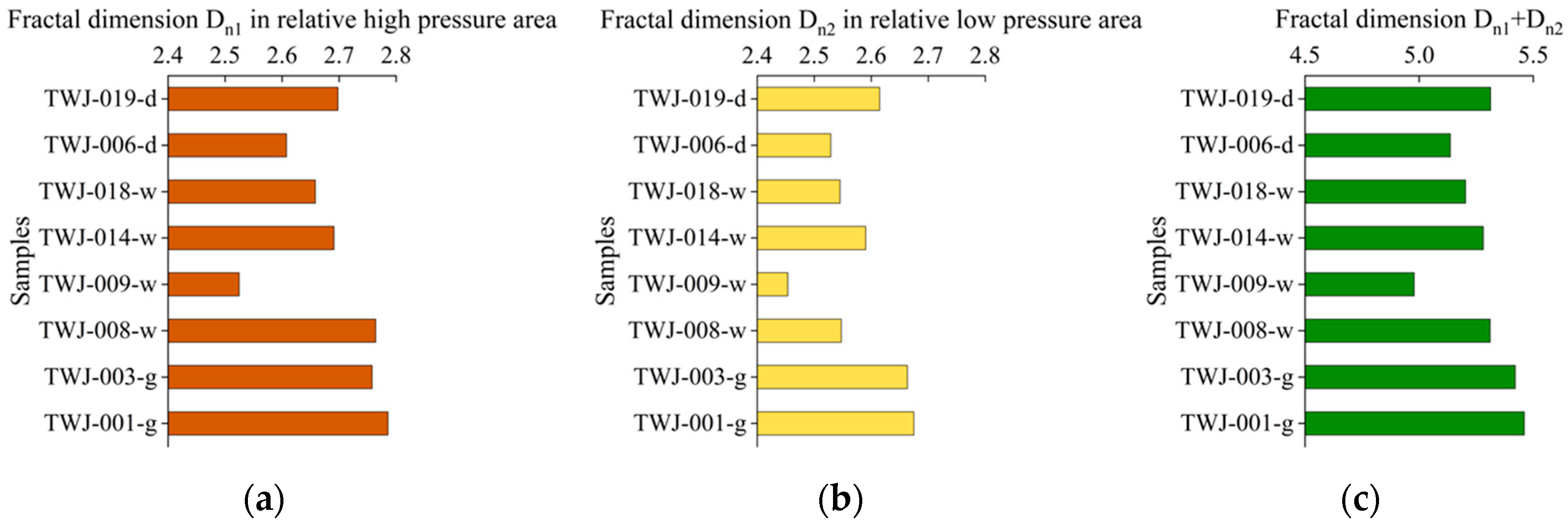
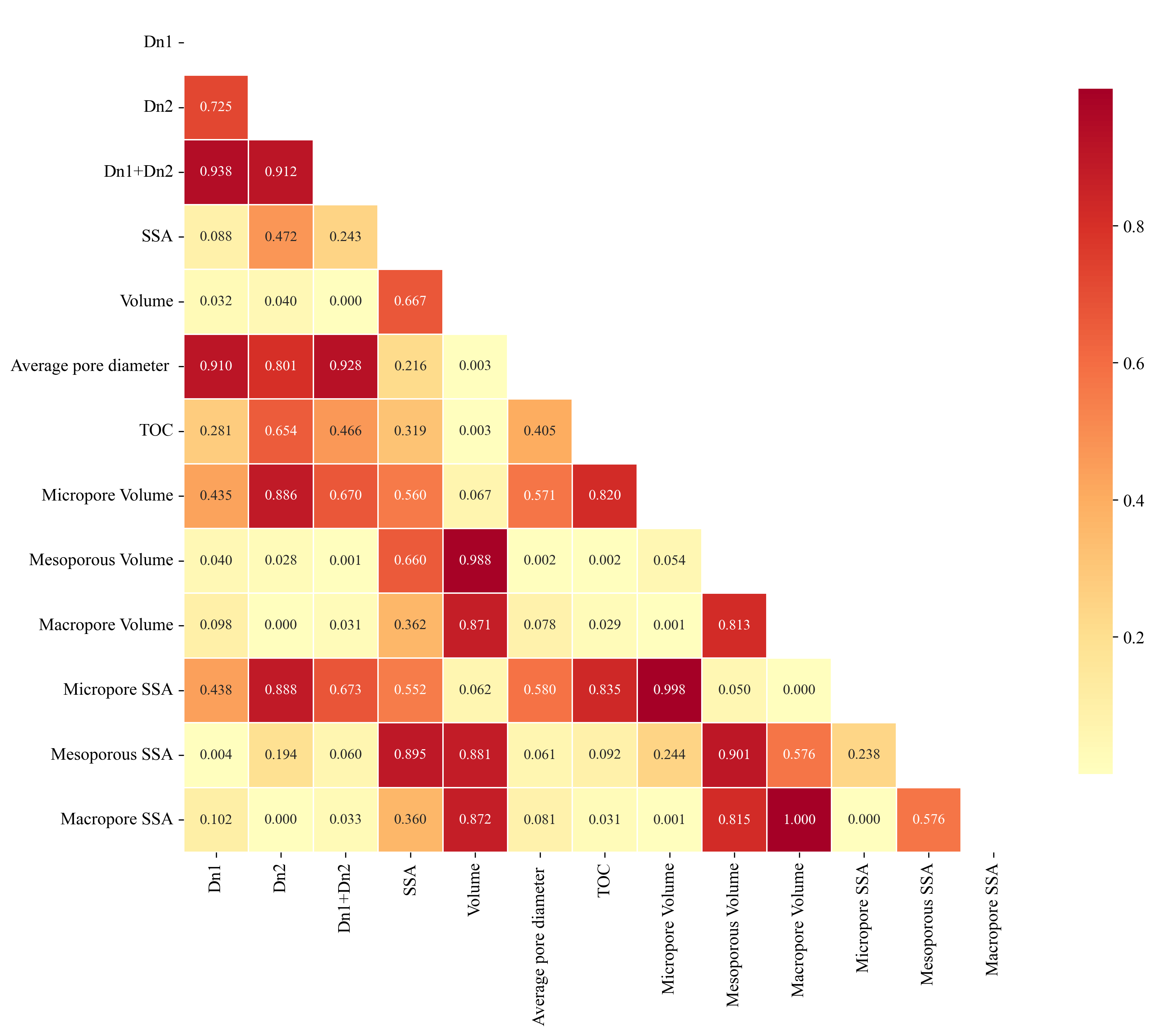
| Samples | Depth (m) | Average Pore Diameter (nm) | BET Specific Surface Area (m2/g) | DFT Pore Volume (cm3/g) | Formation |
|---|---|---|---|---|---|
| TWJ-019-d | 48.35 | 9.04 | 225.6 | 0.45 | Dalong |
| TWJ-006-d | 50.55 | 15.83 | 156.3 | 0.50 | |
| TWJ-018-w | 54.65 | 10.83 | 194.1 | 0.45 | Upper Wujiapin |
| TWJ-014-w | 80.05 | 8.92 | 194.0 | 0.38 | |
| TWJ-009-w | 128.65 | 17.79 | 40.4 | 0.15 | Lower Wujiapin |
| TWJ-008-w | 130.25 | 8.86 | 7.4 | 0.01 | |
| TWJ-003-g | 139.85 | 6.95 | 199.9 | 0.30 | Gufeng |
| TWJ-001-g | 153.65 | 6.50 | 205.1 | 0.28 |
| Samples | Relative Pressure (P/P0) = 0.45–0.95 | Relative Pressure (P/P0) = 0.05–0.45 | Stratigraphic | ||||
|---|---|---|---|---|---|---|---|
| Fitting Equation | R2 | High Relative Pressure D1 | Fitting Equation | R2 | Low Relative Pressure D2 | ||
| TWJ-019-d | y = −0.301x + 4.320 | 0.99825 | 2.6980 | y = −0.385x + 4.323 | 0.99764 | 2.6148 | Dalong Formation |
| TWJ-006-d | y = −0.392x + 3.955 | 0.99465 | 2.6077 | y = −0.471x + 3.983 | 0.99749 | 2.5291 | |
| TWJ-018-w | y = −0.342x + 4.210 | 0.99963 | 2.6585 | y = −0.455x + 4.199 | 0.99788 | 2.5453 | Upper Wujiaping Formation |
| TWJ-014-w | y = −0.309x + 4.213 | 0.99817 | 2.6910 | y = −0.410x + 4.187 | 0.99826 | 2.5904 | |
| TWJ-009-w | y = −0.475x + 2.613 | 0.99906 | 2.5247 | y = −0.546x + 2.645 | 0.99818 | 2.4536 | Lower Wujiaping Formation |
| TWJ-008-w | y = −0.236x + 0.983 | 0.99024 | 2.7642 | y = −0.453x + 0.935 | 0.99862 | 2.5474 | |
| TWJ-003-g | y = −0.242x + 4.201 | 0.99898 | 2.7579 | y = −0.337x + 4.181 | 0.99704 | 2.6634 | Gufeng Formation |
| TWJ-001-g | y = −0.214x + 4.236 | 0.99825 | 2.7858 | y = −0.325x + 4.203 | 0.99808 | 2.6747 | |
Disclaimer/Publisher’s Note: The statements, opinions and data contained in all publications are solely those of the individual author(s) and contributor(s) and not of MDPI and/or the editor(s). MDPI and/or the editor(s) disclaim responsibility for any injury to people or property resulting from any ideas, methods, instructions or products referred to in the content. |
© 2025 by the authors. Licensee MDPI, Basel, Switzerland. This article is an open access article distributed under the terms and conditions of the Creative Commons Attribution (CC BY) license (https://creativecommons.org/licenses/by/4.0/).
Share and Cite
Liu, Y.; Zhang, Y.; He, Z.; Lu, S.; Yang, R.; Li, Y. Heterogeneity and Cause Analysis of Organic Pore in Upper Permian Shale from Western Hubei, South China. Fractal Fract. 2025, 9, 731. https://doi.org/10.3390/fractalfract9110731
Liu Y, Zhang Y, He Z, Lu S, Yang R, Li Y. Heterogeneity and Cause Analysis of Organic Pore in Upper Permian Shale from Western Hubei, South China. Fractal and Fractional. 2025; 9(11):731. https://doi.org/10.3390/fractalfract9110731
Chicago/Turabian StyleLiu, Yang, Yuying Zhang, Zhiliang He, Shuangfang Lu, Rui Yang, and Yifei Li. 2025. "Heterogeneity and Cause Analysis of Organic Pore in Upper Permian Shale from Western Hubei, South China" Fractal and Fractional 9, no. 11: 731. https://doi.org/10.3390/fractalfract9110731
APA StyleLiu, Y., Zhang, Y., He, Z., Lu, S., Yang, R., & Li, Y. (2025). Heterogeneity and Cause Analysis of Organic Pore in Upper Permian Shale from Western Hubei, South China. Fractal and Fractional, 9(11), 731. https://doi.org/10.3390/fractalfract9110731







